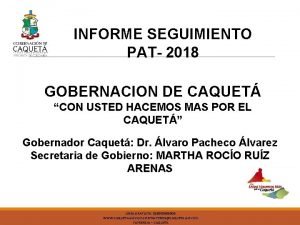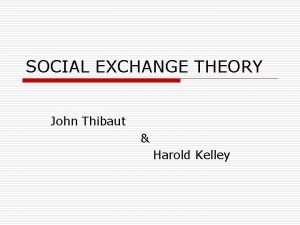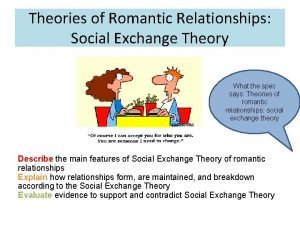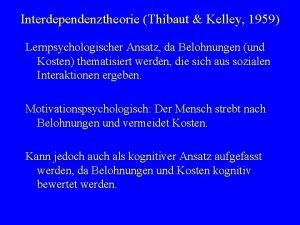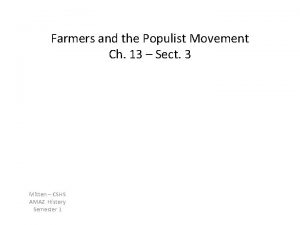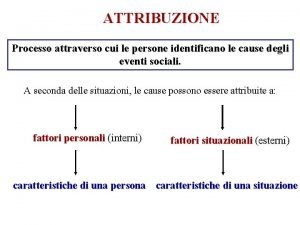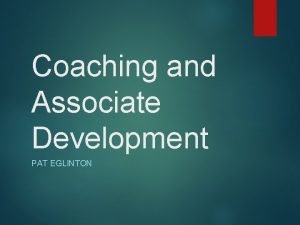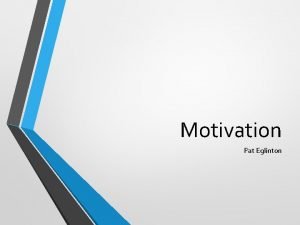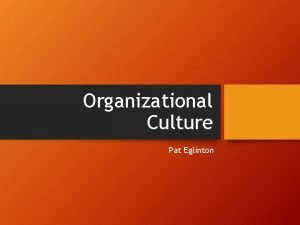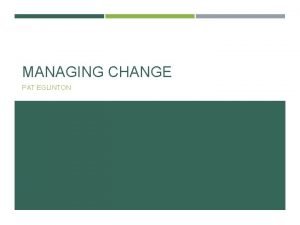Conflict Management Pat Eglinton Agenda Edgar Kelley and











- Slides: 11

Conflict Management Pat Eglinton

Agenda Edgar Kelley and Conflict Management Coaching Articles Conflict Management and Mediation: Key Leadership Skills for the Millennium The Impacts of Leadership on Workplace Conflicts Principles of Conflict Resolution Exercises and Practice Routines

Kelley and Conflict Management The reality is that conflict exists everywhere The introduction of different opinions inevitably results in conflict between individuals Such interaction is necessary for organizational progress: only having a singular opinion might not result in the most efficient or effective course of action Effective leadership does not involve reducing or eliminating conflict; rather, it focuses on the goal of increasing others’ capacity for handling conflict Edgar Kelley : “[c]onflict can be destructive or productive…. A degree of conflict is necessary to a stimulus to creativity and vitality for individuals and organizations”

Kelley and Conflict Management Kelley’s suggestions for effective conflict resolution: Be optimistic Be realistic Identify the potential for conflict Identify the value bases in the opposing points of a conflict Be certain to identify your own span of tolerance Identify the possible and probable outcomes Listen to and communicate with all points of view

Conflict Management Articles The Impacts of Leadership on Workplace Conflicts Conflict Management and Mediation: Key Leadership Skills for the Millennium

The Impacts of Leadership on Workplace Conflicts Two dimensions of interpersonal conflict: Cognitive - task-related conflicts whereby there is a difference in the approach to how the work should get done Relational - Product of emotional incompatibilities Both can produce a negative impact on employee performance and/or workplace satisfaction Transformational leadership involves “encourage[ing] their subordinates to develop their full potential and to transcend their individual aspirations for the good of the organization. ” Combine the elements of collaboration and intellectual stimulation to create a mutual problem to be solved leader's ability to create and common vision and demonstrate individualized consideration of employees Transactional leadership will reduce emotional conflict by clarifying objectives and rewarding food performance

Conflict Management and Mediation If conflicts are left unresolved, then the prospect of collaborative spirit will be shuttered and opportunities for shared learning lost Effective leaders must learn to properly manage it to promote an environment of creativity Create a culture that will highlight the value of individual contributions and new ideas Individuals will feel encouraged and empowered to contribute to the progress of the organization A key factor of this honesty is communicating it both up- and down-wards within the organization

Conflict Management and Mediation ‘PRIDE’ model : coaching others to communicate effectively during conflict Pause – See the other person as your ally – negative reactions will only encourage feelings of defensiveness and/or deepen the conflict Report – Be objective and specific. Avoid generalizations (i. e. ‘You always…’), assumptions or accusations Impact – Describe effects of the other persons behavior on you Different – Be honest/realistic about what you need to be different End Benefit – Point out the consequences/benefits of the change you request

Exercises and Practice Routines Building on Your Strengths

Conflict Management: Building on Your Strengths Take a few moments to reflect and consider whether one of these animals describes you: Ostrich: I hide my head in the sand until the conflict goes away. House dog: I timidly slouch away and chew up the furniture when no one is looking. Hawk: I fly above it all and pick my targets to attack. Coyote: I use my brains to win. Dolphin: I can fight if necessary, but I would rather swim away.

Conflict Management: Building on Your Strengths Reflect back the interaction styles of the elephant, lion and fox. Each has strengths to draw upon to help resolve conflicts. Circle the strengths you recognize in yourself: Elephant: supportive, trusting, adaptable, optimistic Lion: ambitious, competitive, self confident, forceful Fox: analytic, cautious, methodical, fair Describe how you drew upon one of these strengths to resolve a conflict. How might you apply these strengths during a potential conflict in your daily life?
 Ken eglinton
Ken eglinton Pat pat seguimiento
Pat pat seguimiento Agenda sistemica y agenda institucional
Agenda sistemica y agenda institucional Thibaut and kelley 1959
Thibaut and kelley 1959 Examples of social exchange theory
Examples of social exchange theory Interdependenztheorie kelley
Interdependenztheorie kelley Whats external conflict
Whats external conflict What is conflict and conflict resolution?
What is conflict and conflict resolution? External and internal conflict definition
External and internal conflict definition Kelley gallagher
Kelley gallagher Populist party
Populist party Modello anova kelley
Modello anova kelley

